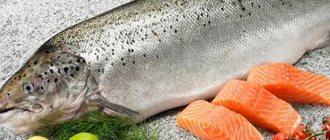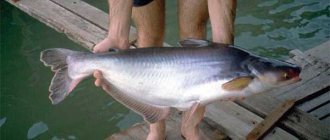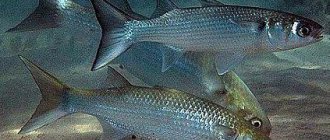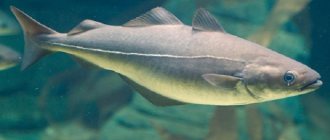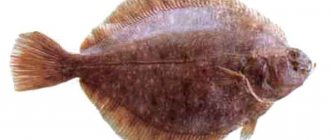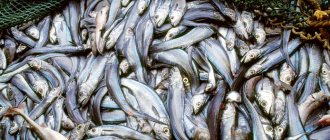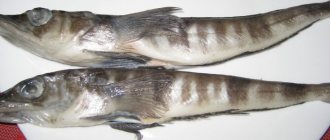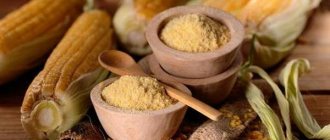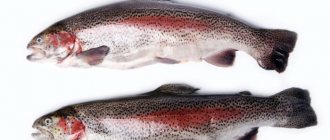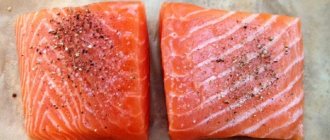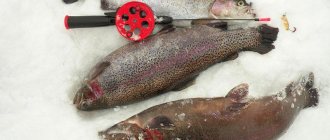- Description Weight and size
- Where does it live?
- What does it eat?
- Taste
Rainbow trout contains omega-3 acids, vitamins A, D, E, group B, sodium, phosphorus, zinc, magnesium, iron, potassium.
Regular consumption helps strengthen blood vessels and lower cholesterol levels. Contains a lot of easily digestible protein. For the greatest benefit, it is recommended to consume mykiss lightly salted. Rainbow trout lives in clean water, its meat does not accumulate harmful substances, so it does not cause any harm. The only limitation is that it should not be eaten by people allergic to red fish.
Description
Mikizha fish
Mykizha looks like a regular sea trout, but smaller in size and with iridescence on the sides. The flesh is not so bright red, but most often pale pink or even light orange. Typically, carcasses weighing 1-2 kilograms go on sale, but there are exceptions.
Kamchatka mykiss is the best choice; it gains weight in the wild.
Fish, properly grown in artificial conditions, is not much inferior to it in taste and benefits. Confusion often arises due to similar names: rainbow trout, river trout and Kamchatka salmon. Mykizha lives in rivers, so it is called river trout and is confused with small fish similar to char.
| Type | Class | Squad | Family | Genus | |
| Mikizha | Chordata | Ray-finned | Salmonidae | Salmonidae | Pacific salmon |
Due to their habitat, rainbow trout are most often confused with small river trout, because they are also found in the river. At a certain point in maturation, it is difficult to distinguish them from each other.
In recipes with portioned river trout, you can use: rainbow, lake and brook trout; they taste approximately the same. But if the recipe calls for large fish, then only rainbow trout will do.
Weight and size
Most often sold in carcasses weighing 1-2 kg, less often in portions of 300 gram fish. It makes no sense to grow it too large; its taste will deteriorate. In its natural environment, rainbow trout can weigh several kilograms, but such fish are less versatile in preparation.
Where does it live?
Rainbow Trout Habitat
Habitat: clean running water with a high oxygen content. In the natural environment it is found in Kamchatka and Alaska, as well as in South America. In artificial conditions in Russia it is bred in all regions. Sometimes mykiss are released into paid water bodies for fishermen.
What does it eat?
Rainbow trout is a predatory fish; it feeds on smaller fish and sometimes eats small crustaceans, insects and eggs of other fish. The taste of the finished fish will depend on the nutrition.
Appearance
White trout. What kind of fish is this? The vast majority of trout representatives are not large in size. Usually their weight is 200-500 g, and their body length is 25-30 cm.
Mainly brook (river) and rainbow trout, which are grown in ponds, pools and cages, have these parameters. Some individuals grow large in size and gain weight up to 2 kg. But such giants can only be found in the wild.
Different types of trout are colored differently. It all depends on the conditions in which the fish grew up. The classic coloring of individuals is those whose backs are dark olive in color with a greenish tint. These fish have light sides with transverse stripes. Small spots of black or dark red color are clearly visible on them (in some individuals they are also surrounded by a light border). The abdomen is white with a hint of gray (sometimes copper-colored).
Basically, one type has predominant light tones, while the other has predominant dark tones. This depends on the transparency of the reservoir in which the fish live, food, time of year and sometimes on the composition of the bottom. For example, light silver fish live in calcareous water, and if the bottom is peaty or covered with silt, then the individuals will have a dark color. If the trout is feeding well, you will not see any spots on its sides. When changing their place of residence, they may appear along with the stripes and disappear again.
The difference between rainbow trout and regular trout
Rainbow trout
Outwardly, mykiss is a little similar to ordinary sea trout; formally, it also belongs to the red fish, but in culinary terms it is very different in taste. Its flesh is a cross between salmon and river fish. The color is always paler than that of marine rocks, sometimes even without red tints.
The main differences between rainbow trout and sea trout:
| Differences | Marine | Rainbow |
| Carcass size | 3-5 kg | 1-2 kg |
| Flesh color | Mostly bright red or bright orange | Pale, sometimes almost white with a creamy tint |
| Scale size | Large scales | Smaller |
| Color of the skin | Silver, homogeneous | Two reddish stripes on the sides. Sometimes they shimmer in several colors |
How to distinguish stale fish from fresh OR “Anatomy of falsification”
A whole segment of defrosted products has appeared on the Russian fish market, which are sold under the guise of chilled ones. To see this, let’s take a look at one of the most expensive and prestigious chain supermarkets.
... And you don’t need to go to the circus. The specialist here has something to laugh at: we enter one of the most expensive and prestigious chain supermarkets. We move to the fish department. Beauty! It's quite elegant here. A spacious counter with a wide assortment attracts attention. 27 types of fish and seafood are neatly laid out on ice. This is where the pleasant impressions end.
First of all, let me remind you that the phrase “chilled fish” is a very specific commodity term, a technical condition with a very specific GOST 814-96. That is, this is one of three generally possible options for selling fish. In the store it can be either live in aquariums, or frozen in freezers, or chilled on so-called glaciers.
To ensure the quality of chilled fish, it is not at all necessary to ask a question to the seller, who will most often answer that “the fish was brought in the morning.” He will not say exactly how long the fish spent traveling from the place of catch to the counter. Moreover, you will not understand this even if you look at the documents accompanying the fish. But a superficial knowledge of geography and fishing will help you avoid running into falsification. It is enough to look at the fish itself and touch it.
Tips for fisherman: How to store trout at home - What is the difference, pros and cons
Professional advice: the simplest and most obvious signs of how to distinguish fresh fish from stale fish
The surface of the fish must be clean, without damage, only slight bruising of scales is allowed. The scales on the body of fresh fish are naturally colored, shiny, hold tightly, and there is no mucus. The body of stale fish is dull or completely dull, the scales are knocked down in places, do not hold tightly, and fall off easily.
An unpleasant fishy smell should also alert you. Fresh fish of normal quality smells of the sea, fresh clean water or ozone, or has no smell at all.
The back and muscles of fresh fish are dense to the touch, the dimple from the pressure of a finger quickly evens out, leaving no marks. The meat of stale fish is darkened, easily separated from the bones, the pit is sluggish under finger pressure and slowly levels out. We look at the abdomen. It is not swollen in fresh fish. In stale ones, it often bursts with or without prolapse of the insides.
And now the simplest thing is to put the fish on your hand or lower it into the water. If the fish does not bend in the palm of your hand and sinks in the water, it is fresh. If it does not sink in the water, but when placed on the hand it bends in an arc, then the fish has gone rotten. You can use a spatula instead of your palm. It is from this absolutely precise point of view of GOST that we continue to examine and feel the product.
Wild species of ocean trout from sea waters go to spawn in mountain rivers and lakes. The males go first to prepare spawning grounds, as with all wild salmon. Males, like all males in nature, are much larger than females, and have a very formidable, intimidating appearance, and also, for their size, they have enormous strength, it is not for nothing that during their journey to spawning grounds, all river species of fish hide in secluded places.
Trout belongs to the salmon family of fish. You can distinguish salmon fish by the adipose fin on top near the tail.
I believe there are two types of trout. This is a freshwater river trout, a very valuable and beautiful type of fish. And very tasty, by the way. There it is possible to distinguish a male from a female only at autopsy. The female has mature or embryonic eggs in her abdomen, and the male, respectively, has milt.
But there is a second type of salmon trout - wild ocean trout, which was cultivated and bred in special reservoirs.
Wild species of ocean trout from sea waters go to spawn in mountain rivers and lakes. The males go first to prepare spawning grounds, as with all wild salmon. Males, like all males in nature, are much larger than females, and have a very formidable, intimidating appearance, and also, for their size, they have enormous strength, it is not for nothing that during their journey to spawning grounds, all river species of fish hide in secluded places.
Unlike females, which are much smaller, have a round nose and do not have a nuptial plumage, male beres dress in nuptial plumage during spawning, these are multi-colored stripes, and, most importantly, they have a huge head ending with a humpbacked nose and a mouth with large fang teeth .
They say that you can look at the heads! I even took a photo of them and thought it didn’t help to compare them, but it’s a little smaller in females (but in relation to the body!) and when there’s one or two fish it’s hard to compare. When they just bring it and there are a lot of them, then it helps (there is something to compare the brightness and heads with)
Posted on 03/05/2018
What to always buy with caviar..
old higher new higher rated
more than a month ago
A funny folk game “Buy trout with caviar.” Answering the question, what would always be with caviar? No way, this is from experience, but to increase the chances of buying trout with caviar, I can tell you how it was for us.
We sell fresh local trout all year round (rainbow trout is what they call it in my opinion). You can buy caviar only in April-May. Caviar is what fish reproduces with (spawning), and fish cannot have caviar all year round!
The age of the fish and the weight (I’m talking about the rainbow fish that are bred on farms) is from 1.5 kg and above, and it is in April-May with a protruding belly, a bright red scarlet/crimson stripe and light scales, and males have bright fins, females do not .Here the chances are high, but buying every week (we eat fish often) it was like everything was as described above, but there was no caviar! The fish had already released the caviar and the stripes became faded and the cup was missing in places.
They say that you can look at the heads! I even took a photo of them and thought it didn’t help to compare them, but it’s a little smaller in females (but in relation to the body!) and when there’s one or two fish it’s hard to compare. When they just bring it and there are a lot of them, then it helps (there is something to compare the brightness and heads with)
But there were heads like females and a large belly and color, but no caviar (as the locals say, fish do not rest every year and go to spawn, there are such things, it turns out). So, in principle, it’s always not possible. And age is important (sexual maturity!) otherwise You can catch up on the weight and feeding conditions and the conditions of detention, but if the age does not apply, where will the caviar come from?!
Tips for a fisherman: How to clean trout eggs from the film - Tips for a beginner
As for the frozen/imported one, I would choose the largest of the lot in size, with a small head (small teeth / but in comparison with others), even scales, a large belly. And if it was caught during the spawning period and it has not yet had time to release eggs, then maybe and you'll be lucky.
Schools of large trout have fewer brethren. Adults hunt alone, finding the best places and protecting their area from competitors.
Talgar, st. Abay (up 3 km.)
Copyright © 2021 | Subject of copyright
Several species of salmon, including 19 subspecies, are called trout. The most famous: rainbow, lake, brook and brown trout, as well as char.
It is capable of reaching speeds of up to 16 km/h. The trout escapes from the predator by jumping out of the water to a height of up to 2 meters, while its speed exceeds 30 km/h.
Schools of large trout have fewer brethren. Adults hunt alone, finding the best places and protecting their area from competitors.
Interestingly, for some reason trout do not like the moon. According to rumors, trout do not hunt and “do not walk” on a moonlit night. Scientific explanations for this phenomenon have not yet been found.
However, there is also a pattern in its behavior - trout comes out to feed (hunt) at dawn and dusk, and prefers to hide during daylight hours. For places of shelter where it stops, it chooses areas near depressions and rifts. There, the trout positions itself with its muzzle against the flow of water, counting on prey accidentally brought by the water. In this position, it is easiest for the fish not to be spooked and not to miss it.
Trout is a very interesting fish, which is good not only on a plate, but also, first of all, on a hook: belonging to the salmon family, when caught it shows remarkable dodging abilities, being considered the most valuable trophy for an angler. Trout fishing is extremely popular in many countries as sport fishing.
Description of trout
The trout's body is slightly flattened laterally, so the fish looks a little flat. The muzzle is truncated and short. The standard size of trout is from 25 cm to 35 cm in length and from 0.2 kg to 0.5 kg in weight. The largest specimens of trout are found in Karelian streams and rivers, which are rich in food - some trout individuals can reach from 1 kg to 2 kg of body weight (a record weight of 5 kg is also known).
The trout has teeth on the vomer: two rows - on the palatal part of the vomer handle and three or four teeth - on the back of the anterior triangular plate. The dorsal fin has 910 branched and 3-4 simple rays, the caudal fin - 17-19, the anal - 317, the ventral - 118, the pectoral - 112. The dorsal fins are covered with dots, the ventral fins are yellow.
Trout color
The color of trout is unstable and prone to transitions: from the back its body usually has a greenish-olive tint, on the sides - yellowish-green, with spots of black, white or red (sometimes with a bluish border), along the belly - grayish-white, often with yellow-copper tint. It often happens that there is a predominance of one tone - for example, a dark color that turns almost black, or, conversely, a light color that turns colorless.
Differences between male and female trout
Female trout differ from males in their larger body size, smaller head size and fewer teeth. Consequently, males, on the contrary, are smaller in body, with a large head and an abundant number of teeth. In mature males, the end of the lower jaws is often bent upward, which makes them just as easy to distinguish from females. The meat of both can be colored in different colors - white, yellowish or reddish.
Trout species
Trout is a comprehensive concept that includes several species of fish (all of them belong to the Salmonidae subfamily of the salmon family). Trout is recorded in 3 of 7 genera of the subfamily.
Trout Habits
Trout is a cautious and fast fish that requires increased patience from the fisherman. Distinguished by her excellent eyesight, she perfectly sees everything that is happening on the shore, so it is very easy to scare her. It is extremely demanding and pretentious in relation to water, which leaves an imprint on the behavior of the fish: the habits of trout change depending on the reservoirs and conditions in which it has to live.
However, there is also a pattern in its behavior - trout comes out to feed (hunt) at dawn and dusk, and prefers to hide during daylight hours. For places of shelter where it stops, it chooses areas near depressions and rifts. There, the trout positions itself with its muzzle against the flow of water, counting on prey accidentally brought by the water. In this position, it is easiest for the fish not to be spooked and not to miss it.
What do trout eat?
In terms of nutrition, trout is completely unpretentious, so it grows very quickly. She knows how to find the larvae of any aquatic insects and catch moths fluttering over the river, boldly jumping out of the water. In the spring-summer season (especially in May-June), flying “feed” allows the trout to gain fat again after the spawning period. At this time, its food consists of mayflies.
Where are trout found?
Trout are abundant in the United States, where they are popular sport fishers. A similar situation is observed in Norway. There are even special fishing and tourism centers dedicated specifically to trout. In general, trout occupies a leading position in countries where a large number of mountain rivers flow.
Tips for fisherman: How to clean trout at home - All the nuances
Trout habitats
Trout Spawning
Spawning of pied trout occurs at the very beginning of autumn - in September. For spawning, it selects shallow water areas, pebbly and rocky soils and fast currents. The laid eggs reach a diameter of 4-5 millimeters and have a reddish or yellowish tone. It has been noted that during the development of a trout embryo, various deviations from the natural course are most often observed. These include albinism, hermaphroditism, deformities in the form of two-headed individuals, etc.
As a rule, salmon, especially wild salmon, costs significantly more than trout . Yes, the final price that the buyer sees in the store consists of many factors, but it is still better to know about the main differences between these two representatives of the salmon family when planning to buy trout or salmon in the store if you doubt the seller.
What color is the meat
Mikizha in section
Mykizha is a red fish, but its flesh is usually pale pink. Sometimes almost white with a cream tint. Color depends on many factors, mainly nutrition.
On sale you can find rainbow trout with light orange and light pink flesh. Mykizha is never bright red like sea trout or bright orange like salmon. The most popular colors are pale pink and light orange.
Taste
Rainbow trout serving option
Rainbow trout tastes closer to salmon than to river fish. It is good in lightly salted, salted form and in dishes where it is baked with vegetables and spices. It has a less bright taste than salmon, but it contains notes of river fish.
Freshly caught rainbow trout has the best taste; it makes delicious dishes. Mykizha can be eaten raw, so they try to cook it quickly; it is permissible to leave the flesh slightly damp.
Bony or not?
Baked rainbow trout
The arrangement of the bones in rainbow trout is exactly the same as in salmon or sea trout, but the bones themselves are smaller, so it is important to properly cut the carcass. The small fish has tender flesh and the spine can be easily removed along with the bones. Large carcasses are cut in the same way as salmon. Remains of bones are easy to feel and remove with tweezers.
Fat or not?
Rainbow trout contains little fat - approximately 3-8%, which is several times less than salmon. Wild caught fish is less fatty. It moves more actively and can contain less than 3% fat. Farmed meat contains up to 8% fat, depending on the feeding system.
The fat of rainbow trout is invisible in appearance; it is contained in the flesh itself, least of all in the tail part, most of all in the abdominal part. This is a healthy fat, so don't give it up. In rare cases, when dieting, it is allowed to use only the tail part and pure fillet of wild fish, then the fat content can be reduced to 2%
Is the fish dry?
In some sources, mykiss is called dryish. The fact is that general rules recommend cooking river fish longer than sea fish, which is why it is often overdried. There is no need for this. Mykizha is more of a salmon than a river salmon in the culinary sense, so it can only be cooked for a short time, like sea salmon.
Any fish will be dry if cooked longer than required. Mykizha is quite capricious and unforgiving of mistakes, so it is better to slightly undercook it than to overdry it. Compared to salmon and sea trout, it is indeed drier, but it has better dietary benefits.
What does a rainbow trout look like?
The body structure of rainbow trout is very similar to that of river trout, but the main differences are in color and body size. The same set of fins, the dorsal fin is not long and relatively high, then on the back, closer to the tail, there is a small adipose fin, like all salmon fish. On the ventral region of the fish there are paired pectoral and paired ventral fins and a powerful anal fin. At the rear there is a strong and powerful caudal fin. The length of rainbow trout aged 4-5 years is usually 50-90 cm, and the weight is 2-4 kg, but there are also large specimens up to 6-8 kg.
The main difference from other species and subspecies of trout is the coloring of the body. In rainbow trout, unlike the usual one, the entire body, except the belly, is dotted with small dark spots from the tip of the nose to the tip of the tail, and a wide rainbow stripe stretches along the lateral line of the body. The body of the amber or golden trout is different in color from the rainbow trout, looks very beautiful and attractive, and has a bright orange or golden yellow coloring of almost the entire body and head, except for the abdominal part, which is more whitish. The fins and tail are also orange.
The meat of rainbow and amber trout is usually bright pink, but sometimes the meat is white with a pink tint or, on the contrary, more red in color. The color of the meat depends on the food the fish eats, what it was fed or what it ate, and also depends on the environment and living conditions of the fish. Rainbow trout meat is tasty and highly valued in many countries. When there is an abundance of food, fish grow very quickly. With the rapid growth rates and cost of rainbow trout meat, it becomes profitable to breed and grow it, which is what many fish farms do.
Beneficial features
Mykizha contains many useful substances
Contains vitamins B, A, D, E. The composition contains elements important for health:
- Phosphorus
- Iron
- Zinc
- Selenium
- Magnesium
Omega-3 fatty acids are especially beneficial. Their content is less than in salmon, but they are easier to digest due to their optimal composition. Regular consumption of rainbow trout reduces cholesterol levels, strengthens blood vessels, and improves memory.
For the greatest benefit, it is recommended to eat mykiss with a side dish of steamed or baked vegetables with a minimum of oil. Ideal side dishes for rainbow trout include asparagus, carrots, celery and spinach greens.
Useful properties and composition of trout
Since trout chooses exclusively clean water bodies for its habitat, its meat is valued at the highest level.
Live healthy! Rainbow trout.(04/21/2017)
Meat composition, vitamins and minerals
Trout meat contains the following beneficial components:
- Phosphorus.
- Yoda.
- Zinc.
- Polyunsaturated fatty acids Omega-3 and Omega-6.
- B vitamins, as well as other vitamins.
Calorie content of trout meat
Trout meat is considered a low-calorie product, since 100 grams contains about 88 kcal . Therefore, nutritionists recommend consuming this fish as a dietary product. This is an ideal option for those who care about their figure.
From a medical point of view
Regular consumption of trout helps fight serious illnesses such as cancer. In addition, the presence of useful components helps fight high blood pressure, improves the functioning of the central nervous system, relieves depressive mood, and improves memory.
Doctors recommend eating trout for people suffering from diabetes, as well as people with heart problems. Trout is probably the only fish that people prone to allergic reactions are allowed to eat.
Trout meat is an easily digestible product that does not burden the stomach.
From a cosmetics point of view
This product will be appreciated by those who watch their weight and figure. In addition, the presence of a whole bunch of useful components in trout meat will be reflected in improving the quality of teeth, hair and skin.
Calories and nutritional value
Calorie content depends on the growing method, size and fat content. On average it is 135 Kcal. Also, a lot depends on the cooking method and the amount of oil used. Boiled and steamed fish are lower in calories than fried fish in butter.
The protein content in rainbow trout pulp is approximately 19-21%, fat content is 3-8%.
The table shows the calorie content for rainbow trout grown in artificial conditions, in Kcal per 100 grams
| Boiled, stewed | Baked without oil | Baked with butter | Fried in vegetable oil | |
| Tail section | 95 | 105 | 124 | 132 |
| Sirloin | 104 | 116 | 137 | 146 |
| Abdominal part | 135 | 149 | 175 | 187 |
Cooking methods
Rainbow trout is suitable for any method of preparation, from rolls to cutlets and dried straws. Lightly salted mykizha is the most delicious. It retains its natural aroma and has delicate pulp. Small portioned fish are most often baked, stuffing the belly with vegetables or boiled rice.
Mykiss makes a rich fish soup. It is simmered and cooked with the addition of vegetables and spices. Portioned steaks from large carcasses are grilled, and clean fillets without skin and bones can be fried in a frying pan using the basic method with the addition of onions and butter.
Mykizha recipes
Mykizha in bacon
Kamchatka rainbow trout has a self-sufficient taste. If desired, mykizhu can be...
View recipe
How to store
To increase the shelf life of chilled mykiss, you need to cut it into portions and wrap each piece in parchment, as is done in a professional kitchen. This method allows the juice released from the fish to be absorbed into the parchment, which increases the shelf life to several days in the refrigerator at a temperature of +2+4 degrees.
Frozen mykiss is stored in the freezer, the shelf life depends on the temperature of the freezer and the method of freezing the fish. Carcasses subjected to shock freezing are stored a little longer, and with proper slow defrosting, they are almost as good in taste as chilled ones.
